What Did It Take To Have A Billboard Top 5 Hit In 2017? Here’s The Breadown
In this extensive piece, Dean Olivet breaks down each song from 2017 that successfully hit the Billboard Top 5, looking at the compilation and structure of each chart topper and providing some technical insight on what made each one a success.
_____________________________
Guest post by Dean Olivet of Soundfly's Flypaper
Alright songwriters and song-guzzlers alike, strap on your boots for a knowledge voyage with more divergent rectangles than the NYC skyline: that’s right, the top pop charters have now become 2017’s top pop graphed. The Top 40 song charters that is, but why 40?
Well, besides this number’s significance in pop music as a result of the Billboard/Nielsen lists, it also just happens that the number of songs in 2017 that cracked the Billboard Top 5 (did I mention that was the primary methodology?) was 39. But then we felt bad for Shawn Mendes — who tried as best he could with his prolific “There’s Nothing Holding Me Back,” only to make it as far up as #6 — so we made him a fake ID and snuck him in through the back. Apparently, there was something holding you back Shawn, 39 other pop songs.
Now, this breakdown is a beast; remember it’s a year’s worth of radio hits. First up, we present the data charts themselves: nine humble music theory analyses of everything from tonalities, keys, and lead singer genders, to total number of appearances of Don Cheadle. Then after that (below), you can find individualized what’s-whats for all of your favorite songs. Enjoy!
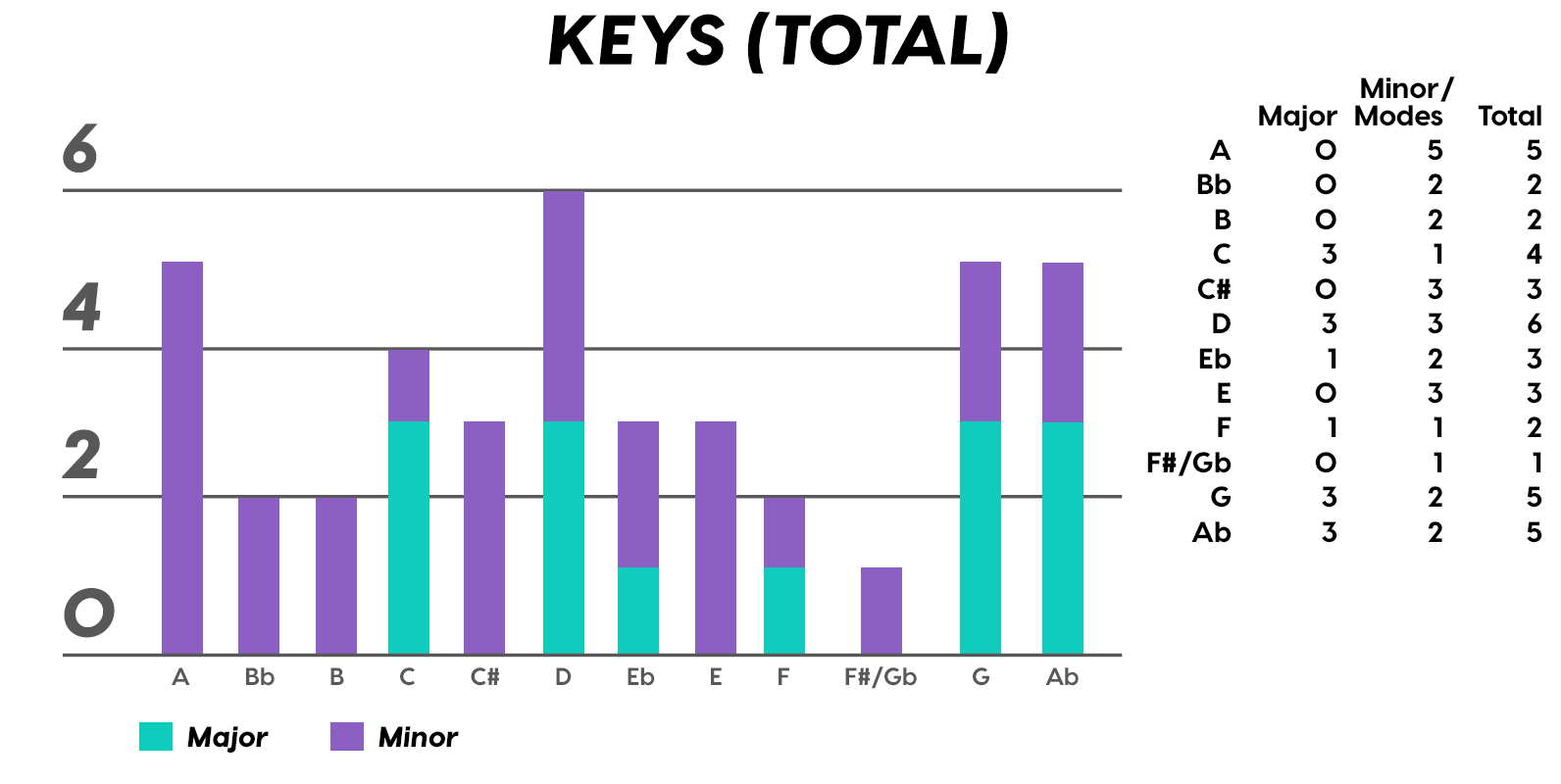
Wow! Move over do re mi, it’s time to drop the “la ti do.” (Incidentally “latido” in Spanish means “musical beat”… where’s a “mind-blown” gif when you need one?)

That’s right, more than 60% of our Top 40 songs (and 80% of the songs that reached #1) are in minor or minor mode keys! Depressed much, 2017?
As for roots, compared to some other macro-music-stat studies I’ve done, last year’s biggest ground gainers were the tonal centers of D and A♭. There was nothing special about G, C, or A(m) — those are the keys of the people. The glaring absence here is the lack of E or A major keys. You can almost always count on these keys in the Top 40 (as E and A are the lowest two strings on a guitar). Chalk it all up to Ed Sheeran’s capo I guess. Seriously though, Millennials — is everything okay?
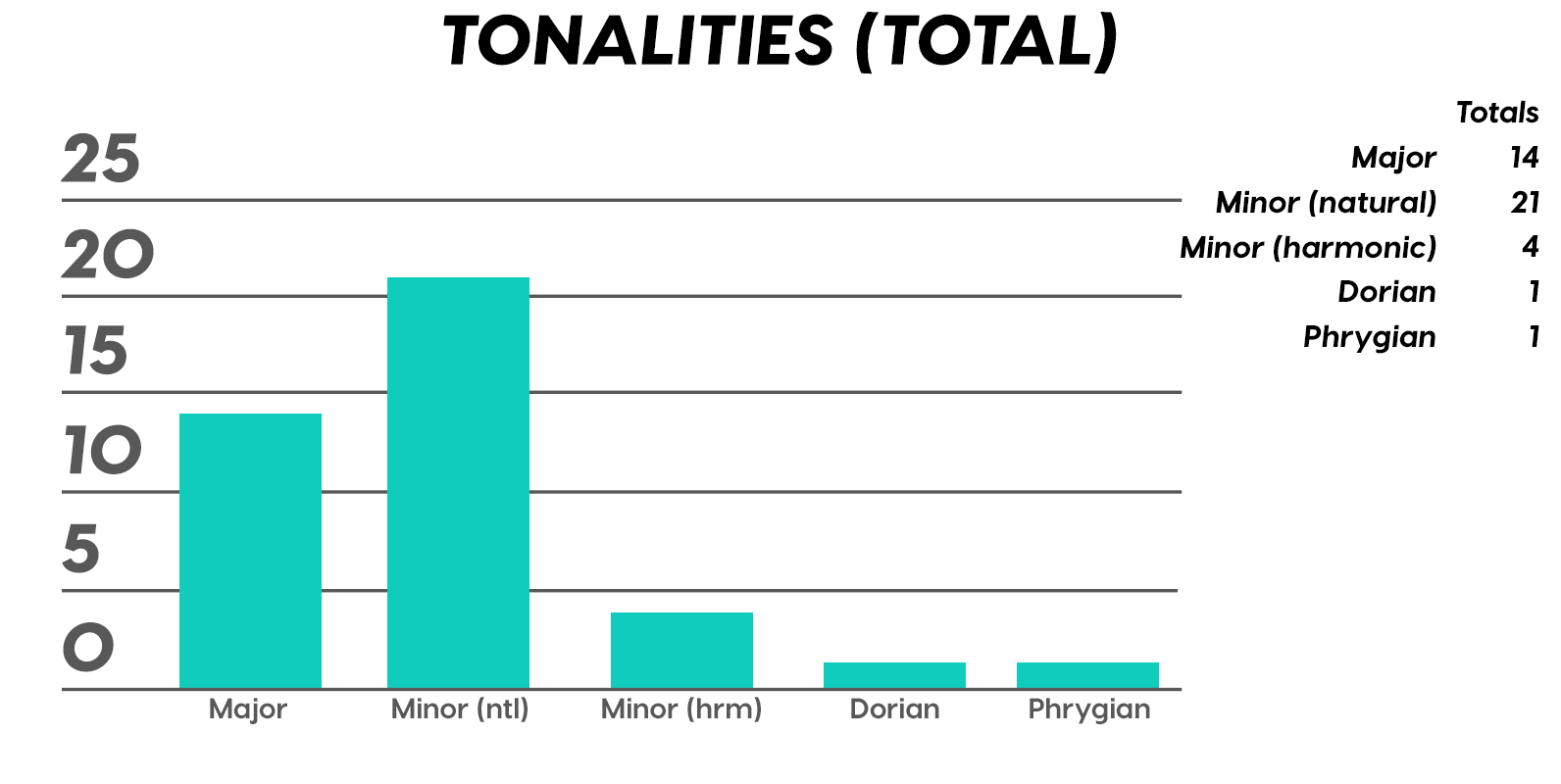
Again, there were so many minor tonalities, we had to split them up. Natural Minor (a.k.a., Aeolian) tallies it way up to win the day, and good old Major holds its humble berth, as expected. Then Harmonic Minor, which is the tonality where you throw in the leading tone (raised 7th scale degree) for functionally delicious V chords. And then the space odyssey minor modes of Dorian and Phrygian for dessert. Seriously guys, good job on making the Top 40, I can’t remember if I’ve seen you here since like, The Doors.

In the olden days, the optimal time limit for a 7-inch single was three minutes, max. And as you can see, those days are way long gone. Like 90% of these singles would’ve been disqualified by the spinny-wax lovin’ DJs of yore. Still, it is of note that 2017 saw Thee Shortest “Hot 100 Top 10” in 42 years, can you guess which song was the shortest? Stay tuned and find out as we go further down this rabbit hole…
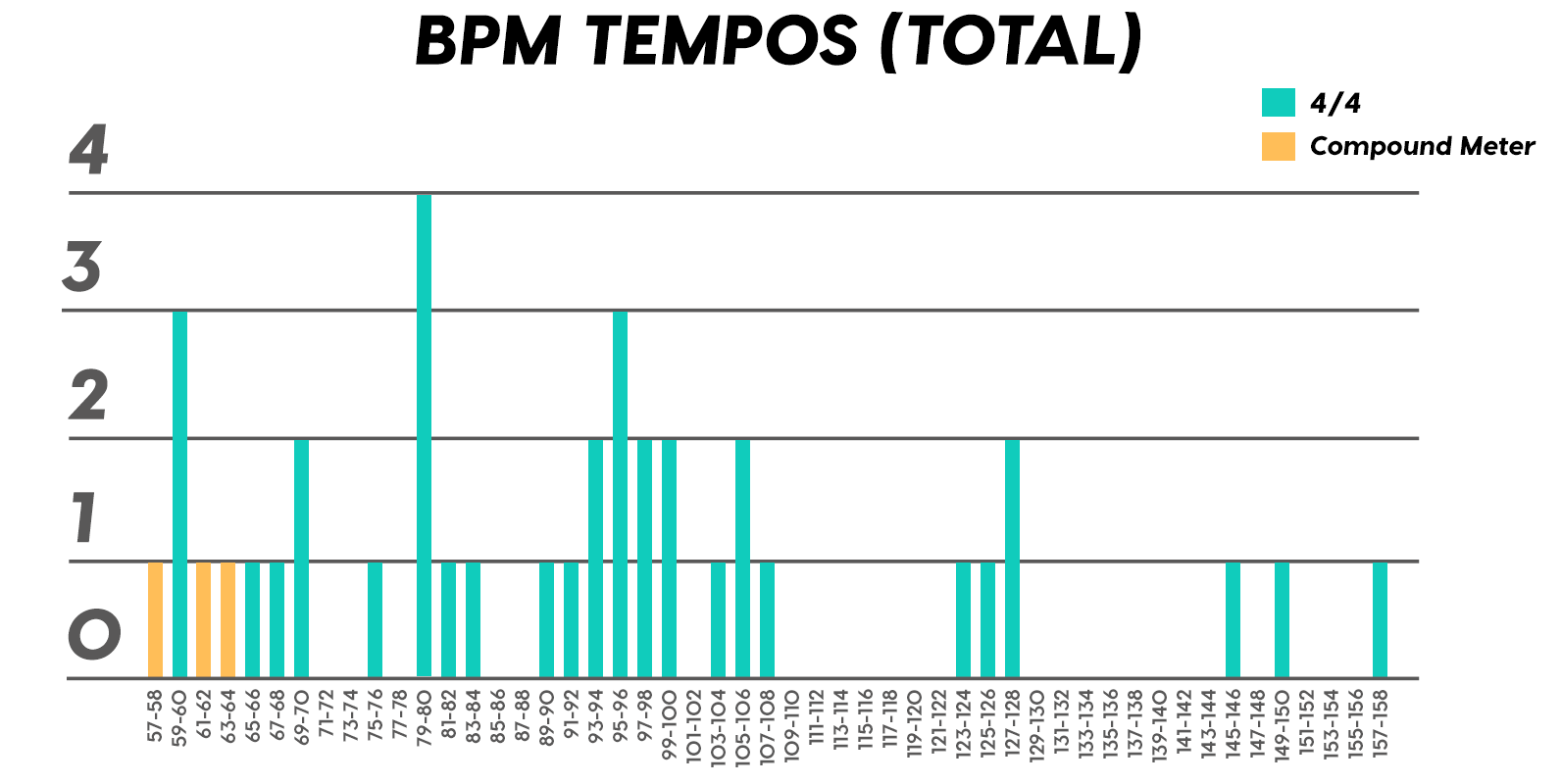
First thing we noticed was, when venturing into triplets land, it’s best to keep that tempo slow (unless you’re in one of those 17-year-cicada-cycles where swing music is in again). Next we got some high action around 80 BPM, our winning tempo of the year. Moving on, a nice healthy critical mass occurred between 90 and 108 BPM, then a tuft from 123-128, and finally, way off to the right, some jams for your Jazzercise class in the 140-150s.
Okay, now can we please talk about the gaping hole from 109-122 BPM? This is crazytown, in other studies, this would’ve been the region with the choicest tenderloin cuts — “God Only Knows,” “Smells Like Teen Spirit,” “Layla,” “Respect,” and, sing it with me: “118 is not my lover, it’s just the tempo that makes your song #1…” (half the songs on Thriller are in this gap actually). Man oh man, anomalicious!
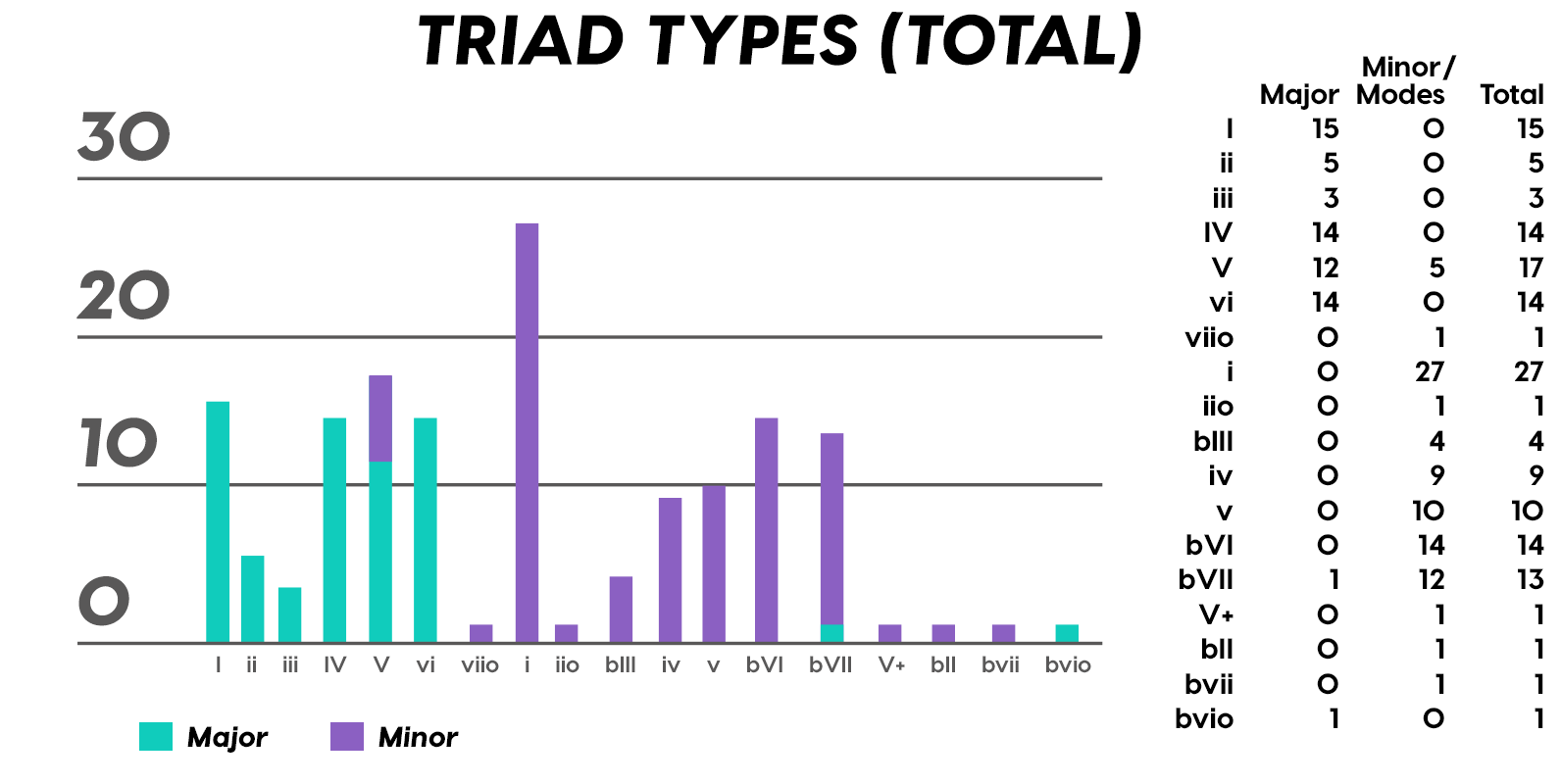
Here’s a chart of Chord-Triad-Type-Appearance Totals, ordered by Major diatonics, then Minor diatonics (chords using notes from the scale and tonality), and then, a few rare animals known as Augmented, Borrowed (a.k.a., Modal Mixture), and Secondary Chords.
The diatonics seem to be behaving themselves, so let’s just point out the stranger things. First, look at the vii° chord, it’s purple (signifying the chord was found in a minor song) when it should be green! This means it was “borrowed” from minor (aeolian)! Next, the tiny green sliver in the♭VII column is another of our “borrowed” chords, this time major-minor vice versa. Last, the four chord types all the way to the right are diatonic to neither major nor minor. The V+ (augmented) chords are really their own thing, like Sriracha, not really part of any actual food group, just thrown in for some spicy chromatic-passing-tone heat. Next the♭II, which is borrowed from phrygian, and finally we have the♭viº and♭vii chords, which are “secondary function” chords (vii°/vi and ii/♭VI, respectively).
Don’t try this at home kids. Or actually, do try this at home. Remember, the only rule worth a damn in music theory is: if it sounds good, it’s right. And now, we’ll add a relevant plug to Soundfly’s newest Mainstage courses, where you can learn how to harness the power of moods in music and go beyond cliché diatonic chord progressions using nothing but simple harmonic technique, Unlocking the Emotional Power of Chords and The Creative Power of Advanced Harmony. Moving on…
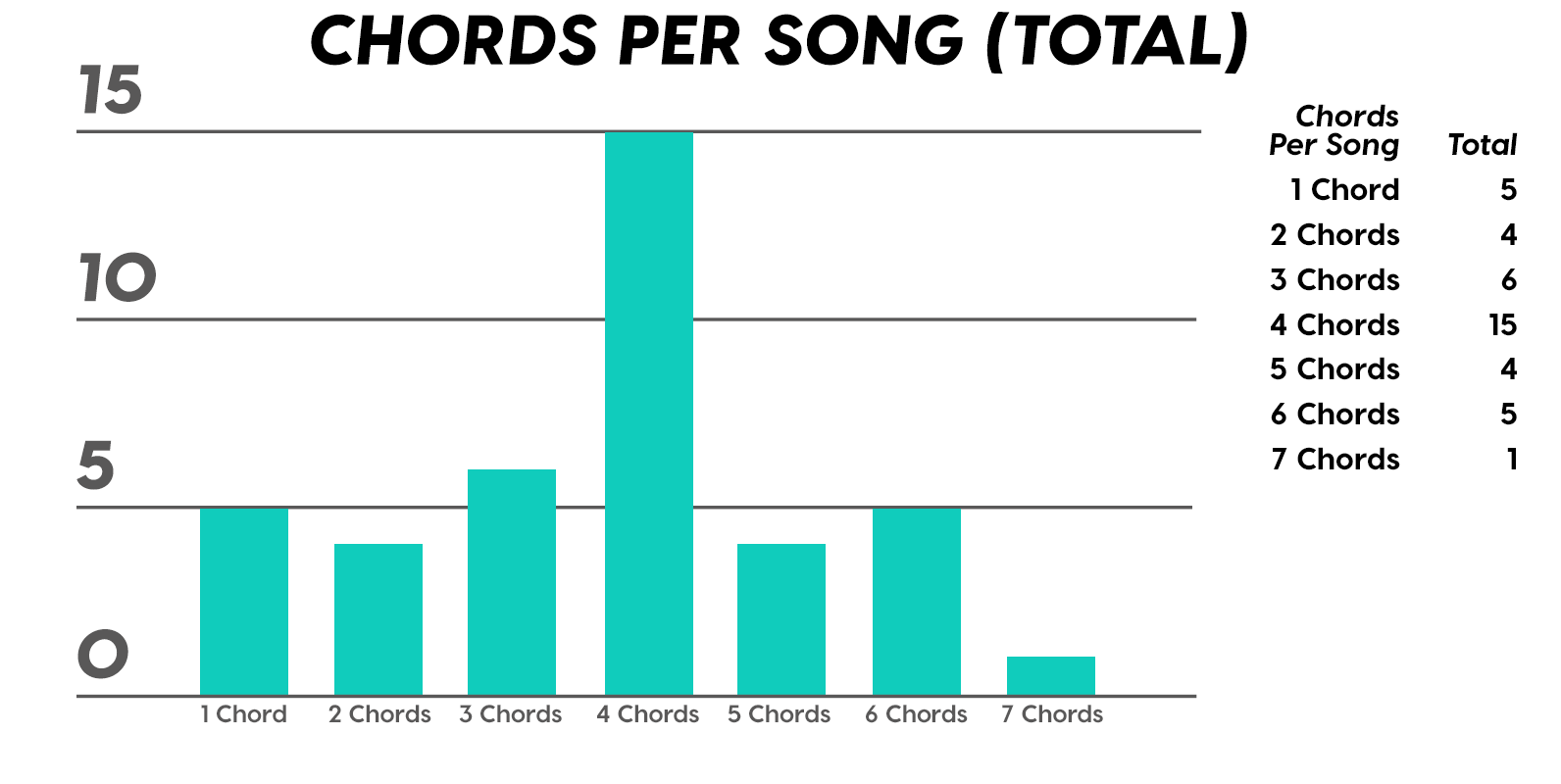
Newsflash: the 4-chord song still reigneth supreme! Meanwhile, 1-chord and 6-chord songs slightly outdid 2-chord and 5-chord songs, which is sort of interesting if you think about it. Disclaimer: the 7-chord song in this study blipped its way in by being the only song to modulate to another tonality. Hey… is it just me, or does anyone else feel like this chart is flipping me off?
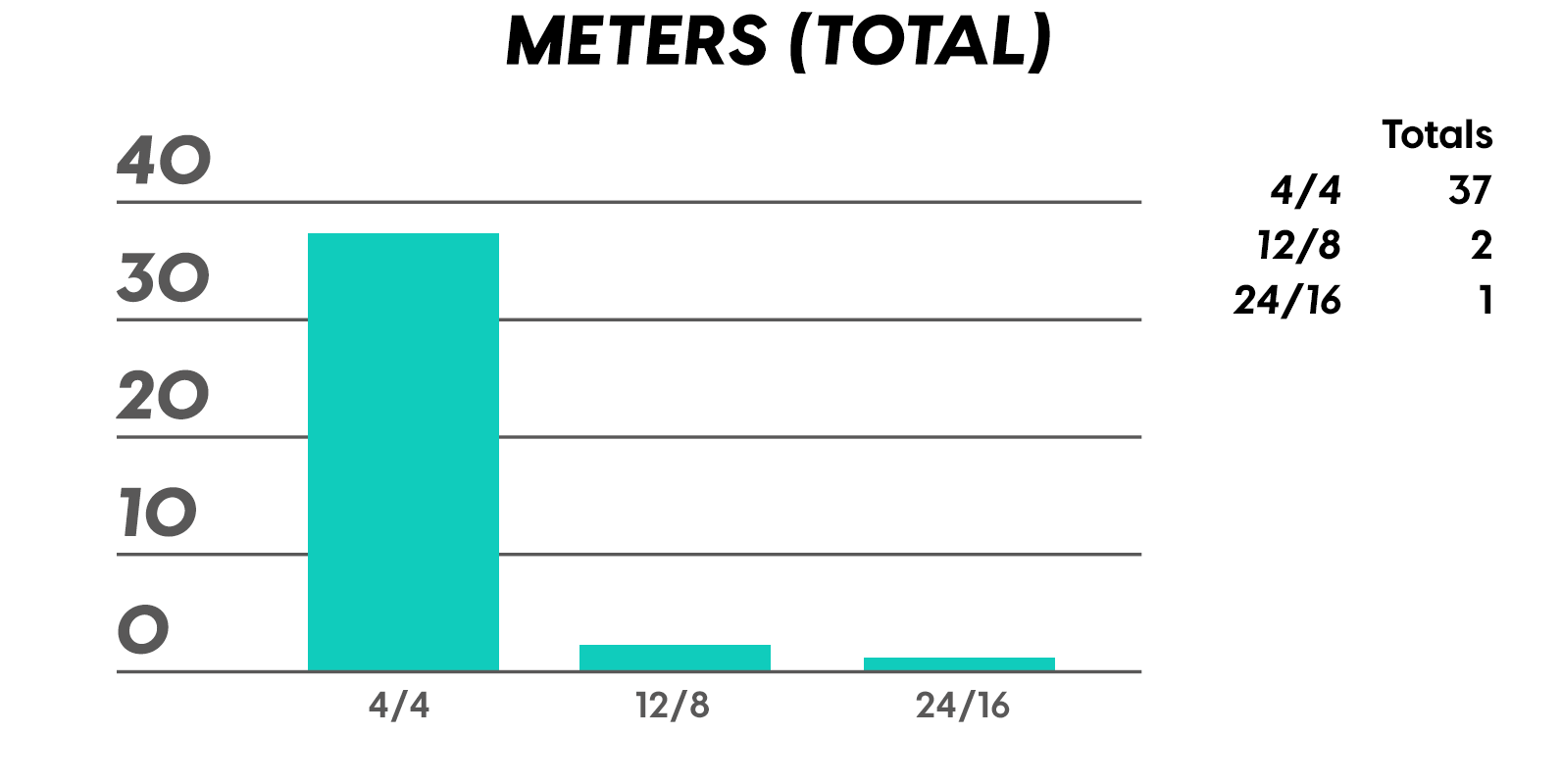
Here you can see exactly why 4/4 is referred to as “common” time. Other than that we just have a few compound meters, including a 24/16, courtesy of some sexy sextuplets imagined by some dragons. Cut time, 2/4, and 3/4 have all been banished until hipsters bring back polkas and waltzes once moustaches and mini butter-churners have run their course.
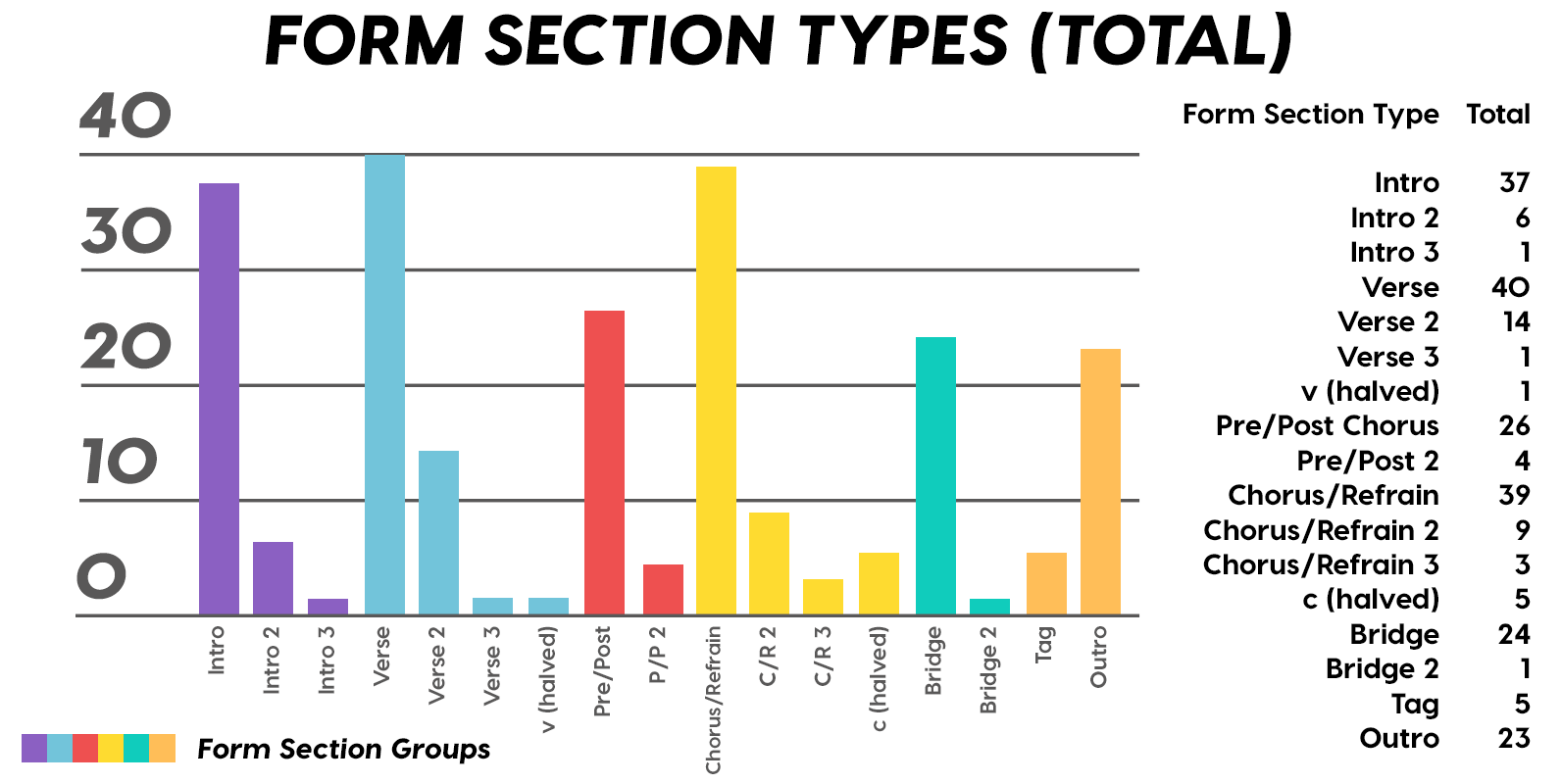
I really can’t think of any time I’ve seen or heard of a song without a Verse, Top 40 or otherwise. The gauntlet has been thrown down, kids. Get a song with no Verse into the Top 40 (or even up to a thousand plays on YouTube) and I will give you $5. Intros are a wee bit more prevalent these days than normal, but the real news story is the abundance of Pre-Choruses, and even a few Post-Choruses — once only mythical possibilities — pop’s songwriting cachet continues to grow beyond projections.

So, how you look at this one is… subjective. I mean, we’re obviously skewed toward the dudes here, by a lot. But on the other hand, that’s how it’s always been. No matter how you look at it, “pop gender parity” is objectively improving on a macro scale. But on the other hand, Don Cheadle (the actor) had more appearances in this study than the one Female Duet, and that duet failed the Bechdel test (where two women talk to each other about something other than a man). So yeah, we still have a ways to go people, speed it up.
And now, without further ado (or further a-la if you’re in minor), here’s Part 2 of our partially insane, totally amazing breakdown of:
Every song in 2017 that cracked the Billboard Top 5 (*plus one scrappy extra tune that almost made it)
Ordered by total weeks spent in the Top 5, let’s start with the song that utterly tore this year to shreds.

Form: I(4) – V(8) – P(8) – C(16) – V(8) – P(8) – C(16) – B(8) T(.5) – C(16)
Let’s talk about the “shape” of the Chorus. You could semantically split it into both a Chorus and a Refrain if you wanted. I know you’ve heard it a million times, but listen again and decide for yourself. Also did you ever notice the half-measure break before the last Chorus? I love that trick, but unfortunately that’s not why this song topped the charts in basically every country with a radio station, (except for some reason Colombia). It even made it all the way up to #15 on the US Latino Pop chart! (Okay well that was the Latin remix, but still, who do you think gets those kush royalty checks in their mailbox?)

Form: I(1) – V(8) – P(4) – C(8) – V2(8) – P(4) – C(8) – B(8) – C2(7.5)
This song carries the flag for all the many modern pop tunes that can’t pick a tonal center. I call this music “slickery.” But if I gotta pick, I’ll go with minor, since common terms fit better, but you could also hear it in lydian if your ear is latching on to the first chord. If anything, the V7 in the Bridge is what makes it minor over lydian.

Form: I(14) – I2(4) – V(16) – C(8) – P(8) – V2(8) – B(8) – T(1/2 bar) – C(8) – P(8) – c2(4) – B2(8)
This song actually beat out “Shape of You” for most weeks at #1, so take that Anglos! Listen at 1:24 for the smooth slow-down, it’s like the song has something to do with “slowing down” or something. The Intro also takes liberties with the beat, (again, “latido” in Spanish, which is a word they somehow managed to not rhyme in this song). Whatever the translation, the lyrics make the song-form more diverse than Puerto Ricoitself: alt Intros, alt Verses, alt Choruses, and alt Bridges. The Outro Bridge even incorporates lyrics from the Post-Chorus. Very cool.

Form: I(8) – C(16) – V(32) – C(16) – V(32) – C(16) – O(8)
What really strikes me about this one is Cardi’s rhythmic motif where she throws out two quick syllables, then leaves the rest of the count empty, for a bullet-like “d-da, d-da, d-da” attack. I heard this motif a lot this year, in more than a few songs on this list. Listen for it here and elsewhere, and if you want another treasure hunt, try to find the other song further down with an almost identical minor scale 2^♭3^ 5^ (“ti do mi”) motif.

Form: I(4) – C(8) – P(4) – V(12) – C(8) – P(4) – V(12) – C(8) – P(4) – V(12) – C(8) – P(4) – O(8)
I’m calling the “Oh-eh-oh” section a Post-Chorus here because that’s how I think it functions in the song, but if you want everything fit into a nice 12-bar repetition, just call the whole thing a Chorus. Also note the beat-dropouts in the last few Verses, they threw me off, very fun.

Form: I(8) – C(16) – V(32) – C(16) – V(32) – C(16) – V(32) – C(16) – O(8)
The E major sounding “do do mi re do” motif right before the first Verse heralds our uncommon “♭II” chord presence in the loop. I’m not 100% sure on the meter and tempo in this song either — you could feel this at 64 BPM just as well, if you don’t mind 32nd notes. Whatever the meter, that lyrical “d-da, d-da” motif is back in force for Lil Uzi Vert’s verse. I mean, you got to set yourself apart when you’re rapping with someone who’s had a whole rhythmic style named after him (google “Migos Flow”).

Form: I(4) – C(9) – V(16) – C2(8) – V(16) – C2(8) – O(11)
It’s hard to say if this song has more than one chord. The way I hear it, it’s a C minor thing in the Intro, and then you’re just swimming in a fish tank of G minor the rest of the song. So that’s either a modulation, or it just started on the “iv” chord, take your pick. The phrase leading up to the first Chorus stretches it to 9 bars rather than your regular 8, and the Outro has an irregular number of bars too. And I just love how the phrasing obfuscates where the different sections begin or end.

Form: I(4) – V(32) – C(16) – V(32) – C(16) – O(8)
At 155 BPM, the tempo of this song can feel like it wants to go half-time, but when in doubt, go with the mass of head-nods. If we’re being honest, there are really zero chords here, just riff notes. And, because of the lack of chords and only three notes, I’ve heard some say they hear this in Phrygian, and I dig that. I also dig the hard cut-off on the Outro.

Form: I(4) – V(8) – C(6) – I2(4) – V(8) – C(6) – I2(4) V2(22) – C(6) -B(6) – I2(8)
Hey hey! You ever been blessed by Santana with his blessing? Full steam ahead! First, listen to that imported major V chord from 1999 making music happen like it used to do. The other smooth thing here is the uncommonly lengthed 6-bar Chorus, which the Bridge (if you want to call it that) is based on. Also the uber-extended last Verse has some trickery in the chord order you should be made aware of. Again, do try this at home.

Form: I(4) – V(8) – P(8) – C(8) – P2(8) – V(8) – P(8) – C(8) – P2(8) – C(8) – O(20)
How can this song be in A♭ if the loop is D♭ E♭ Fm? Answer: just go with it, function is overrated. Seriously though, it’s the melodic content that dictates the A♭ center. And just listen to how the opening melody note makes for an add9 chord, it’s kind of counterintuitive but it works because it’s the root of the chord right before it. The form here is atypical too. Both a Post- and Pre-Chorus? Yeah, really. I mean they ain’t Bridges. This is a classic case where form section labels can also benefit when communicated alphabetically, where the sections would be like: (I)-A-B-C-D-A-B-C-D-C-D2-(O).

Form: I(4) – V(4) – P(4) – C(8) – V(4) – P(4) – C(8) – B(8) – C(12) – O(4)
The diminished chord sometimes connecting the “V” to the “vi” needs a loud shout-out here, listen for it. Meter and tempo again can be subjective. 59 BPM is pretty darn slow, but that’s just what my gut tells me, you could also notate this as 2/4 instead of 4/4, if you so chose. Last, this is one of the many songs these days keeping the tonic/root chord in the middle of the changes and away from the ends or beginnings of phrases. This is part of a larger trend in music these days where we’re turning down the gravity, and moving away from “functional” changes and resolutions like “I-IV-V-I.”

Form: I(8) – P(8) – C(8) – V(8) – P(8) – C2(8) – V2(16) – P(8) – C3(8) – -B(8) – V3(8) – O(8)
This song wins the award for playing off the click before the beat comes in, giving it an organic feel — so refreshing in today’s digitized world. Tonally, another one that puts the root-chord in the middle, for a never-resolved loop. Formwise, I’m stretching here; the Bridge is really a “vocal Instrumental,” which I don’t have a letter for. The last Verse is tweaked so it feels like a Bridge, and the Outro uses enough Chorus material that maybe it’s just another variation… Now if you’ll excuse me, this song got me in the feels, and I have to go finish crying by myself.

Form: V(8) – I(4) – C(6) – V(8) – I(4) – C2(4) – B(8) – C3(6) – O(8)
And the Diatonics Award goes to: “Thunder” by Imagine Dragons — all six (main) major diatonics! (we don’t talk about “vii°” anymore, not since he was tragically eaten by “V7”) Every Chorus is a little different, so that’s cool too. The Bridge is really an Instrumental, but I’m still calling it a Bridge because of the new harmonic material.

Form: I(8) – V(16) – P(8) – C(8) – V2(16) – P(8) – C(8) – B(24) – C(16)
Here’s our second song so far peppered with harmonic minor flavors that you don’t hear as much these days. There’s also a relatively extended Bridge making room for dramatic material, as well as a Double Chorus at the end. Take special note of the minor “v” chord inversion, used where most mere mortals would just plop down your rock-usual “♭VII,” nice tweak Taylor.

Form: I(4) – C(8) – V(8) – P(8) – C(8) – V2(16) – C(8) – B(16) – C(8) – O(8)
Got to love the janky piano sample in this song, always refreshing to hear anything that’s not polished or auto-tuned in the Top 40. Of course, if you’ve ever tried to auto-tune a piano…
…Anyways, we’re halfway done with the article! This might be a good time to stretch your legs.

Form: I(4) – V(8) – P(8) – C(8) – V(8) – P(8) – C(8) – V(8) – P(8) – C(16)
The beat drops out in the third Verse as well as the Pre-Chorus sometimes in this song, just to keep the loop a little fresh. Otherwise, just a super tidy 8-8-8 bar construction.

Form: I(16) – C(16) – V(24) – C(16) – V(24) – C(16) – V(24) – C(16) – O(24)
I didn’t write anything clever for this one because for some reason I thought it’d be fun to play a Beatles reference drinking game while studying. And well… you get the idea.

Form: I(4) – V(16) – P(8) – C(16) – V2(8) – P2(8) – C(16) – V2(8) – B(4) – C(16)
Meter is tricky in this one. At first, you feel it in common time at around 62 BPM, but then you notice the sextuplets. It’s because of these I’m going with 24/16. That way, I get to keep the rock rule of having the snare on 2 and 4. If you think I’m a crazy person, reference Prelude No. 15 from The Well-Tempered Clavier by Bach. What you won’t find in J.S.’s cool-keys preludes are the empty first-beat fake-outs in the Choruses still making me fall on my face while I’m trying to count on my fingers. Harmonically, ’twas a bold choice to go with the seldom seen borrowed viiº instead of the V7. Well I mean, not that bold, let’s say “adding a wheatgrass shot” level bold.

Form: I(4) – C(8) – V(8) – C(8) – O(3)
Dude.
Post.
Modern.
Ism.
Also, the shortest Hot 100 “Top 10” in 42 years … I just, can’t. Even.

Form: I(?) – C(8) – V(8) – P(8) – C(8) – V(8) – P(8) – C(8) – B(16) – C(8) – O(8)
What a yummy free-styling chord Intro: a “i11” to start, where the bottom triad drops out for a “♭VII”, then passing chromatic thirds to a “♭VIM7”, then a “V7#9” (a.k.a., the Hendrix chord), even a “ii°7,” saving the “iv7” for the main loop. Ain’t no chord triad without some kind of bling on it up in here. Also, dig that funky-time acid-clock Bridge, they got me shook! Turns out it’s just 16 bars with the accents in all the “so-wrong-they’re-right” places. Excuse me while I go fix my face.

Form: I(4) – C(28) – V(8) – P(4) – C(24) – V2(16) – P(4) – c(4)
As a pop musicophile, I always find it amusing when I get academically offended. The sections in this song are all kinds of anti-textbook, keeping me in check! Like the first — I guess we’d call it the Chorus since it’s repeated — is this 28-bar stream of consciousness thing, and then the second time it comes around, the 3rd and 4th stanzas disappear, inexplicably, for no reason. And then the Verse is only 8, but no, wait, then it’s 16. And there’s this 4-bar Pre, or maybe Post-Chorus thing, or wait, maybe it’s a Refrain? And then the end is just the last four bars of the Chorus they lopped off because, again, no textbook reason, just felt like it I guess.
Of all the songs on this list, this one gets the award for Most Subversive Form. I’m so offended, and I like that.

Form: I(4) – V(8) – P(8) – C(16) – V(8) – P(8) – C2(16) – P(8) – B(8) – C3(20)
This song is also not following my song form rules. The Chorus changes every dang time, makes me want to promote the Pre-chorus up to full Chorus status to take its place. And then, the Bridge is more like an Instrumental, which is messing with my system. Also they just added a few chords, so now I’m grumpy I can’t make fun of them for using the same chords as their other song on here. Foiled again!

Form: I(8) – V(8) – C(16) – V(8) – C(16) – V2(16) – B(8) – P(8) – C(16)
Wow, the third Verse in this song gets severely tweaked as we get a shiny new chord and a longer, lustrous melody makeover. Then after the Bridge, there’s a surprise Pre-Chorus section, or you could also think of it as an extended-longer, lustrous Chorus. And, make sure to take in the subtle blue note flavors that seem to be leaving pop music as we grow more digital.

Form: I(4) – V(8) – P(8) – C(8) – V(8) – P(8) – C(8) – B(8) – P(8) – T(1) – C(8) – O(8)
The Verses in this one are these kind of hybrid things, since they utilize the same lyrics for half. You wouldn’t think it, but this practice is quite uncommon in the craft of songwriting. I mean it’s just not something one thinks to do. Also uncommon is giving the Chorus the thinnest instrumentation, at least to start (just a slappy bass). The Outro is a hybrid of the Bridge and Chorus. You guessed it, uncommon. And this, ladies and germs, is why lots of people describe “creativity” as simply combining things that ain’t been combined before.

Form: I(4) – C(8) – V(8) – P(4) – C(8) – V(8) – P(4) – C(8) – B(4) – P(4) – C(8) – O(4)
This song wins the award for 2017’s Most Canon in D Like. Also, someone needs an award, or at least a dopey-faced high-five, for setting a song about love-making to a “69” BPM click.

Form: V(8) – P(8) – C(8) – I(2) – V(8) – P2(8) – C(8) – I2(4) C(8) O(4.5)
Hey look it’s Ed Sheeran again with the last of our twelve #1’s for 2017! This time he’s got a Pre-Chorus section that changes about half the lyrics to make it kind of this Pre-Chorus-Verse type thing. Can’t remember when I’ve seen something like this before, at least not to this degree of lyrical tinkering.

Form: I(8) – V(8) – P(8) – C(8) – V(8) – P(8) – C2(16) – P(8) – C2(16) – O(15)
Oh man, this song starts on the “iii” chord, then going to a “vi” — a sneaky-great way to delay the ear’s grasp of the real tonal center. It’s a harmony-equivalent to blasting the fog machines before you take the stage. Also don’t miss all that dafty play-around on the double Choruses we’ve come to know and love from our friendly robots.

Form: I(4) – C(8) – V(12) – C(8) – V2(16) – C(8) – O(8)
The Intro to this one starts off a few clicks fast and then slows down, you can almost hear where they dragged the mouse in their DAW. Also, cool cut-n-paste in the second Verse of what sounds like a sample of a church choir or something, maybe that’s why they made it longer than the first Verse. This kind of digital craftsmanship is why I think it’s time everyone put DAWs in the same category as instruments themselves, like they should be included in elementary school posters and like, puzzles and stuff.

Form: V(8) – P(8) – C(12) – V(8) – P(8) – C(16) – B(8) – c(8)
Those guitar double-stops in the second Verse, they really spank my heart. Ouch. But the songwriter’s trick to study-and-steal here is how the Choruses are shaped each time. The first is 12 bars, split into this 8-bar setup thing followed by a Title Refrain part that lasts 4 bars. Then, the second time the Chorus comes, the Title Refrain half extends to 8 bars, adding a brand new stanza, “no way that you’ll see me cry.” This new material is itself repeated as an 8-bar bridge to allow Smith some riffin time. Finally, for the last Chorus, only one Title Refrain is sung! This leaves the song with a “cut-short” feeling, proving he is, in fact, very “good at goodbyes.”

Form: I(8) – V(20) – C(12) – V(20) – C(12) – O(2)
A fade-in fake-out! I love these! So, because you miss where the backbeat is initially, there’s no telling what your brain is gonna do to try and to make sense of it in this one. Unfortunately, you can only get wrecked by it once, because after your brain has processed the beat, you can never have that same lost-and-found feeling again.
Also, wait: Dorian?! Rad, guys! You got that raised sixth scale note in the loop all by itself hanging right there. The Verses have a non-standard length, with some wicked tricky bass accents throwing you off in the middle. Also, the Chorus is non-standard because it tacks on a Refrain for extensions. All that aside, this song wins the Cracking Me Up award.

Form: I(8) – V(4) – C(8) – B(4) – V2(8) – C(8)
This song gets the award for Most Out Of Breath — it sounds like they were playing capture the flag with the microphone before takes. I mean, they’re having a lot of fun here, I love how the first Verse starts out like it’s gonna be a regularly lengthed Verse but instead giggles itself short to get straight to the Chorus.

Form: I(2) – V(16) – I2(8) – V2(12) – C(4) – I3(4) – B(12) – C(4) – V(8) – C(4) – O(7)
Like most of the songs out there unbound by chord changes, describing the form in traditional terms in “Mi Gente” is tricky. Without much harmony, there’s a lot more room to make each section its own thing, so that’s usually what happens. There’s a clear Hook with the title in it, but other than that, all sections take their own liberties with the melody, lyrics, and number of measures.

Form: I(4) – V(8) – C(8) – V(8) – C(8) – B(8) – C2(10)
This song gets the award for A Song That Has Guitar In It. Pretty cut and dry, but it can be tricky when the Verses incorporate Refrain material — especially Title Refrain material. It leaves it open to different form descriptions. Again, most young songwriters don’t think to do this, like they’ll get in trouble or something. Lady Gaga assures you: do what you want, make it easy breezy; copy yourself, ain’t no red markers ‘round here.

Form: I(4) – V(8) – P(4) – C(8) – I2(2) – V(8) – P(4) – C(8) – I2(2) – B(4) – P(4) – T(.5) – C(8) – B(4)
A modulation!! Just a direct to relative-major modulation, but a modulation nonetheless. This being 2017, I really didn’t think we’d see one. I wonder: is the modern lack of modulations in Pop because of entitled millennials who want all their modulations handed to them? Or, are they just living more frugally these days, not wasting key changes willy nilly like their parents, with no thought to the long term consequences?
If it’s true we’re the first generation in a long time that will end up having less than our parents, I guess maybe that includes modulations? Moving on, the last Pre-Chorus section in this one has some yummy “sus” and “add” chords on the “♭VI” and “♭VII” chord roots, followed by a half-measure tag to boot.

Form: c(4) – V(8) – P(4) – C(8) – V(8) – P(4) – C(8) – B(4) – V2(8) – P2(4.5) – C(8) – B(4)
This Verse melody does-not-compute. Seriously, listen to it. It’s like, one note too low. I mean it sounds pretty fresh but it’s all kinds of against the rules to put the tonal center of a melody one note off the key. This is going to be stuck in my head for a long time, I just know it. Also, starting with a Half-Chorus? Brilliant. Let’s see, what else… it’s got a nice extension of the last Pre section, and don’t you think it was quite hospitable to give the featured artist both a Verse and two whole Bridges, the second of which even closes the song!

Form: I(4) – V(8) – P(8) – C(8) – V(8) – P(8) – C(8)
I love how the first Chorus bleeds into the next Verse here, and the next Chorus bleeds into absolutely nothing. Next, I don’t have a term to describe what I’m calling the Pre-Chorus. There are really two different Pre-Choruses in this one. Or, maybe the first part could perhaps belong to the Verse before, that would be kosher. That “♭VII” borrowed chord (a.k.a., modal mixture) is a chord popularized in the the same era when these slow compound meter songs were all the rage.

Form: I(2) V(16) – P(4) – C(16) T(1) – v(8) – P(4) – C(16) – B(9) – c(8) – O(8)
Am I crazy or did someone just spray Rasta-flavored cotton candy all over Pink Floyd’s “Another Brick in the Wall?” I for one, as a self-styled nonconformist, wholeheartedly approve. I mean, the kids are alright is what I’m saying. “Time is ticking for the Empire” indeed, #wokekatyperry… Anyhow, very heavy form shaping going on here, what with the Half-Verse and Half-chorus, as well as the Tag and the Bridge extension.

Form: V(32) – [tempo change!] B(4) – V2(??) – O(??)
Like “Humble”, another of Lamar’s songs on this list, the key we’re in in “DNA.” is subjective because of a lack of concrete tonal information. I’m going with Phrygian this time instead of minor, because we’re camping on the Phrygian root twice as long. Formwise, this is pretty much free-verse over 4-bar chunks, there’s a part in the middle that repeats the opening phrase, which I’ll call the Bridge (just for the heck of it) as the beat changes to 130 BPM, leaving the music theory 101 solar system completely. This is some genius free-verse unbound s#*t. I could spend the rest of the day figuring out where to draw the lines here, but sometimes you just have to let it be and wait for the copycats to provide a little more context.

Form: I(4) – V(8) – P(8) – C(8) – V(8) – P(8) – C(8) – P(8) – B(8) – O(16)
Here we have the award for Most Beatles-Aesthetic Torches Carried In A Song. Like sandwiching a Chorus in between two Pre-Choruses, I mean then the second one becomes a Post-Chorus, technically, but whatevs. Ooh, doesn’t that IV chord in the Bridge land like a boulder from the heavens? That is, after thinking for the last four whole minutes, “where the heck is the four chord?” Pure pop planning (or perhaps it just happened that way, who knows).

Form: I(4) – V(8) – P(8) – C(16) – V(8) – P(8) – C(16) – B(16) – C2(16)
Check out this variation of never landing on the root. Okay: because of centuries of tradition, we have to assume this is in D major, but we’re thrown into a tonal jello bowl when the root is only ever played on an off beat, and in the middle of the measure! And then the main chords — IV, V, and vi — are off the downbeat themselves. Formwise, you could totally separate the Chorus into two independent 8-bar sections and call them what you want, I just wouldn’t since there’s already a Pre-Chorus.
Whoa! Holy crap! Are you still here?
Now, we’ll give You get the award for Most Hungry To Get To The Bottom Of Whatever I’ve Just Spent The Last 30 Minutes Reading. I hope any or all of the “I-didn’t-know-you-could-do-thats” were interesting and inspiring. Tune in next year for the tonal tricks of 2018! Until then, try to keep your attention on a million perfect, unforgettable, 24-karat magic reasons to be chained to the rhythm like a bad and boujee rockstar.